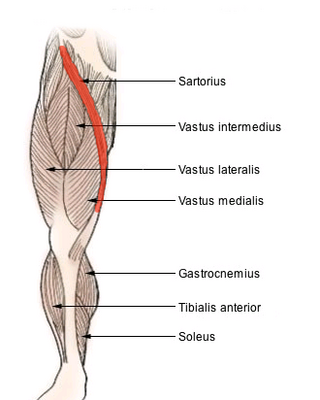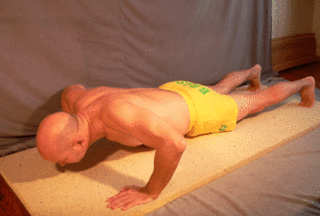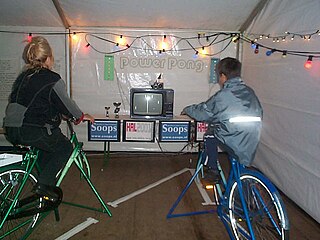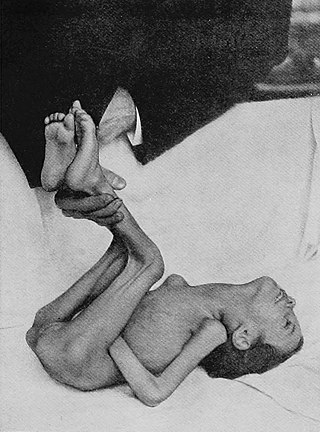Related Research Articles

Arthritis is a term often used to mean any disorder that affects joints. Symptoms generally include joint pain and stiffness. Other symptoms may include redness, warmth, swelling, and decreased range of motion of the affected joints. In some types of arthritis, other organs are also affected. Onset can be gradual or sudden.

Running is a method of terrestrial locomotion allowing humans and other animals to move rapidly on foot. Running is a type of gait characterized by an aerial phase in which all feet are above the ground. This is in contrast to walking, where one foot is always in contact with the ground, the legs are kept mostly straight and the center of gravity vaults over the stance leg or legs in an inverted pendulum fashion. A feature of a running body from the viewpoint of spring-mass mechanics is that changes in kinetic and potential energy within a stride co-occur, with energy storage accomplished by springy tendons and passive muscle elasticity. The term running can refer to any of a variety of speeds ranging from jogging to sprinting.

The human leg, in the general word sense, is the entire lower limb of the human body, including the foot, thigh or sometimes even the hip or gluteal region. However, the definition in human anatomy refers only to the section of the lower limb extending from the knee to the ankle, also known as the crus or, especially in non-technical use, the shank. Legs are used for standing, and all forms of locomotion including recreational such as dancing, and constitute a significant portion of a person's mass. Female legs generally have greater hip anteversion and tibiofemoral angles, but shorter femur and tibial lengths than those in males.

Calisthenics or callisthenics (/ˌkælɪsˈθɛnɪks/) is a form of strength training consisting of a variety of movements that exercise large muscle groups, such as standing, grasping, pushing, etc. These exercises are often performed rhythmically and with minimal equipment, as bodyweight exercises. They are intended to increase strength, fitness, and flexibility, through movements such as pulling, pushing, bending, jumping, or swinging, using one's body weight for resistance in pull-ups, push-ups, squats, etc. Calisthenics can provide the benefits of muscular and aerobic conditioning, in addition to improving psychomotor skills such as balance, agility, and coordination.

The sartorius muscle is the longest muscle in the human body. It is a long, thin, superficial muscle that runs down the length of the thigh in the anterior compartment.

The push-up is a common calisthenics exercise beginning from the prone position. By raising and lowering the body using the arms, push-ups exercise the pectoral muscles, triceps, and anterior deltoids, with ancillary benefits to the rest of the deltoids, serratus anterior, coracobrachialis and the midsection as a whole. Push-ups are a basic exercise used in civilian athletic training or physical education and commonly in military physical training. They are also a common form of punishment used in the military, school sport, and some martial arts disciplines.

Cock and ball torture (CBT) is a sexual activity involving the application of pain or constriction to the penis or testicles. This may involve directly painful activities, such as genital piercing, wax play, genital spanking, squeezing, ball-busting, genital flogging, urethral play, tickle torture, erotic electrostimulation, kneeing or kicking. The recipient of such activities may receive direct physical pleasure via masochism, or emotional pleasure through erotic humiliation, or knowledge that the play is pleasing to a sadistic dominant. Many of these practices carry significant health risks.

The crunch is an abdominal exercise that works the rectus abdominis muscle. It enables both building "six-pack" abs and tightening the belly. Crunches use the exerciser's own body weight to tone muscle and are recommended by some experts, despite negative research results, as a low-cost exercise that can be performed at home. According to experts like Canadian biomechanics researcher Stuart McGill, crunches are less effective than other exercises such as planks and carry risk of back injury.

An isometric exercise is a form of exercise involving the static contraction of a muscle without any visible movement in the angle of the joint. The term "isometric" combines the Greek words isos (equal) and -metria (measuring), meaning that in these exercises the length of the muscle and the angle of the joint do not change, though contraction strength may be varied. This is in contrast to isotonic contractions, in which the contraction strength does not change, though the muscle length and joint angle do.

Fitness game, exergame, and gamercise are terms used for video games that are also a form of exercise. Fitness games rely on technology that tracks body movement or reaction. The genre has been used to challenge the stereotype of gaming as a sedentary activity, and promoting an active lifestyle. Fitness games are seen as evolving from technology aimed at making exercise more fun.
The biceps femoris is a muscle of the thigh located to the posterior, or back. As its name implies, it has two parts, one of which forms part of the hamstrings muscle group.

Muscle & Fitness is an American fitness and bodybuilding magazine founded in 1935 by Canadian entrepreneur Joe Weider. It was originally published under the title Your Physique, before being renamed to Muscle Builder in 1954, and acquiring its current name in 1980. There is also a companion magazine called Muscle and Fitness Hers, oriented toward women.
Nautilus, Inc., located in Vancouver, Washington, United States, is the American worldwide marketer, developer, and manufacturer of fitness equipment brands Bowflex, Modern Movement, Nautilus, Schwinn Fitness, and Universal. The products are sold globally to customers through a combination of television commercials/infomercials, the Internet, call centers and retail stores.
The knee examination, in medicine and physiotherapy, is performed as part of a physical examination, or when a patient presents with knee pain or a history that suggests a pathology of the knee joint.

Kernig's sign is a test used in physical examination to look for evidence of irritation of the meninges. The test involves flexing the thighs at the hip, and the knees, at 90 degree angles, and assessing whether subsequent extension of the knee is painful, in which case it is deemed positive. This may indicate subarachnoid haemorrhage or meningitis. Patients may also show opisthotonus—spasm of the whole body that leads to legs and head being bent back and body bowed forward.
Whole body vibration is a generic term used when vibrations of any frequency are transferred to the human body. Humans are exposed to vibration through a contact surface that is in a mechanical vibrating state. Humans are generally exposed to many different forms of vibration in their daily lives. This could be through a driver's seat, a moving train platform, a power tool, a training platform, or any one of countless other devices. It is a potential form of occupational hazard, particularly after years of exposure.

The Abdominizer was an abdominal exerciser invented in 1984 by Canadian chiropractor Dennis Colonello and marketed through infomercials by the Fitness Quest corporation of Canton, Ohio, selling around six million.

Fitness culture is a sociocultural phenomenon surrounding exercise and physical fitness. It is usually associated with gym culture, as doing physical exercises in locations such as gyms, wellness centres and health clubs is a popular activity. An international survey found that more than 27% of world total adult population attends fitness centres, and that 61% of regular exercisers are currently doing "gym-type" activities. Getting and maintaining physical fitness has been shown to benefit individuals' inner and outer health. Fitness culture has become highly promoted through modern technology and from the rising popularity of social media platforms.

Jacki Sorensen is the American originator of aerobic dancing, popularly known as aerobics. Inspired by Dr. Kenneth H. Cooper's 1968 book on aerobic exercise, she created for women an aerobic dance routine to music in 1969 in Puerto Rico, teaching U.S. Air Force wives. She expanded this concept into a teaching method and studio franchise, Aerobic Dancing Inc., that rose to 1,500 locations and 4,000 instructors teaching 170,000 students in 1981 at its peak.
References
- ↑ Berkman, Meredith (1992-05-22). "Suzanne Somers and the ThighMaster". EW.com. Retrieved 2020-06-17.
- ↑ O'Neill, Molly (1995-03-29). "Time for a Fitness Pyramid?; After Thigh Master, a Stream of Fitness Gadgets". The New York Times. Retrieved 2010-12-22.
- ↑ "A Meeting Of Behinds With A Thigh Master". Sun Sentinel. March 8, 1995. Retrieved 2020-06-17.
- ↑ "Advice on fitness gadgets: try to exercise restraint". Orlando Sentinel . 1996-01-26. Retrieved 2020-06-17.
- ↑ "Suzanne Somers' Thigh Master - As Seen On TV Fitness Products: Do They Work?". Shape Magazine. 2012-10-28. Retrieved 2018-10-27.
- 1 2 Friedlander, Whitney (2009-01-05). "Working out old school: Is it time to pull out the ThighMaster?". The Los Angeles Times . Retrieved 2020-06-17.
- ↑ "The Newest ThighMaster Vibrates, Is Finally Useful". Jezebel.com. 24 April 2015. Retrieved 2015-10-22.
- ↑ "Suzanne Somers Says Her Vibrating ThighMaster 'Makes Sex More Enjoyable'". HuffPost. 2015-04-17. Retrieved 2020-06-17.
- ↑ "Obituary: Dr. Anne Marie Bennstrom Prescott 1928-2018". Idyllwild Town Crier. Retrieved 24 September 2019.
- ↑ "Physical exerciser USD343882S". Google Patents. USPTO. Retrieved 24 September 2019.
- ↑ T.M. Shine (1993-03-17). "Inventor Of The Thighmaster Stays On The Ball". Orlando Sentinel. Retrieved 2020-06-17.
- ↑ "O.C. inventor squeezed ThighMaster into American culture". Ocregister.com. 5 December 2013. Retrieved 2015-10-22.
- ↑ "Thigh Master - In Photos: 10 Corny But Effective Cable TV Ads". Forbes. Archived from the original on October 6, 2011. Retrieved 2015-10-22.
- ↑ Voorhees, Don (3 May 2011). The Indispensable Book of Useless Information: Just When You Thought It ... - Don Voorhees. ISBN 9781101514795 . Retrieved 2015-10-22.
- ↑ "Debunking 4 Popular Exercise Fads – Advanced Physical Medicine". Advancedphysicalmedicine.org. 2013-02-18. Retrieved 2015-10-22.